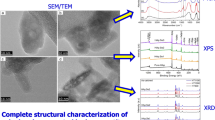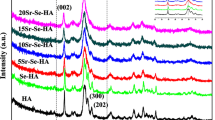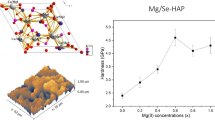Abstract
In this work, the influence of the morphology of hydroxyapatite particles on silicon substitution through hydrothermal synthesis performed under the same conditions was investigated. Spherical- and whisker-like hydroxyapatite particles were obtained starting from calcium-nitrate, sodium dihydrogen phosphate, disodium-ethylenediaminetetraacetic acid and urea (used only for the synthesis of whisker-like particles) dissolved in aqueous solutions. Silicon was introduced into the solution using tetraethylorthosilicate. X-ray diffraction, infrared spectroscopy, scanning electron microscopy, energy-dispersive X-ray spectroscopy and transmission electron microscopy indicate that silicon doping induce different phase compositions and bioactivity of spherical- and whisker-like hydroxyapatite particles obtained under the same hydrothermal conditions. Silicon-substituted, spherical hydroxyapatites particles showed greater phase transformation to silicon-substituted α- calcium-phosphate compared with whiskers-like hydroxyapatite particles synthesized with the same amount of added silicon. Metabolic activity assay performed with SaOs2 osteosarcoma cells showed better biocompatibility of annealed biphasic spherical-like particles compared with annealed whiskerlike particles while dried spherical-like particles induce high cytotoxicity effect.








Similar content being viewed by others
References
Bohner M. Calcium orthophosphates in medicine: from ceramics to calcium phosphate cements. Injury. 2000;31:37–47.
Kikawa T, Kashimoto O, Imaizumi H, Kokubun S, Suzuki O. Intramembranous bone tissue response to biodegradable octacalcium phosphate implant. Acta Biomater. 2009;5:1756–66.
Elliot JC. Structure and chemistry of the apatites and other calcium orthophosphates. Studies in Inorganic Chemistry. Amsterdam: Elsevier; 1994.
Dorozhkin SV. Calcium orthophosphates. J Mater Sci. 2007;42:1061–95.
Best SM, Porter AE, Thian ES, Huang J. Bioceramics: Past, present and for the future. J Eur Ceram Soci. 2008;28:1319–27.
Ferandez E, Gil FJ, Ginebra MP, Driessens FCM, Planell JA, Best SM. Calcium phosphate bone cements for clinical applications. Part I: Solution chemistry. J Mater Sci: Mater Med. 1999;10:169–76.
Racquel Z, LeGeros JP. Dense hydroxyapatite. In: Hench LL, Wilson J, editors. An Introduction to Bioceramics. Singapore: Word Scientific; 1993. p. 139–80.
Yamada MO, Tohno Y, Tohno S, Utsumi M, Moriwake Y, Yamada G. Silicon compatible with the height of human vertebral column. Biol Trace Elem Res. 2003;95:113–21.
Webster TJ, Massa-Schlueter EA, Smith JL, Slamovich EB. Osteoblast response to hydroxyapatite doped with divalent and trivalent cations. Biomaterials. 2004;25:2111–21.
Jell G, Stevens MM. Gene activation by bioactive glasses. J Mater Sci Mater Med. 2006;17:997–1002.
Gibson IR, Best SM, Bonfield W. Chemical characterization of silicon- substituted hydroxyapatite J. Biomed Mat Res. 1999;44:422–8.
Arcos D, Rodrı′guez-Carvajal J, Vallet-Regi M. Silicon Incorporation in Hydroxylapatite Obtained by Controlled Crystallization. Chem Mater. 2004;16:2300–8.
Sayer M, Stratilatov AD, Reid J, Calderin L, Stott MJ, Yin X, MacKenzie M, Smith TJN, Hendry AJ, Langstaff SD. Structure and composition of silicon-stabilized tricalcium phosphate. Biomaterials. 2003;24:369–82.
Balas F, Pérez-Pariente J, Vallet-Regí M. In vitro bioactivity of silicon-substituted hydroxyapatites. J Biomed Mater Res. 2003;66A:364–75.
Anselme K. Osteoblast adhesion on biomaterials. Biomaterials. 2000;21:667–81.
Thian ES, Huang J, Best SM, Barber ZM, Brook A, Rushton N, Bonfield W. The response of osteoblasts to nanocrystalline silicon-substituted hydroxyapatite thin films. Biomaterials. 2006;27:2692–8.
Davies JE., Surface characterization of biomaterials. In: Ratner BD, editor, Amsterdam; Elsevier: 1998. p 219-34.
Ruys AJ. Silicon-doped hydroxyapatite. J Aust Ceram Soc. 1993;29:71–80.
Tanizawa Y. Suzuki T. Effects of silicate ions on the formation and transformation of calcium phosphates in neutral aqueous solutions J Chem Soc Faraday Trans. 1995;91(19):3499–503.
Boyer L, Carpena J, Lacout JL. Synthesis of phosphate-silicate apatites at atmospheric pressure. Solid State Ionics. 1997;95:121–9.
Gibson IR, Huang J, Best SM, Bonfield W. Enhanced In Vitro Cell Activity and Surface Apatite Layer Formation on Novel Silicon-Substituted Hydroxyapatites. Bioceramics. 1999;12:191–4.
Aizawa M, Patel N, Porter AE, Best SM, Bonfield W. Syntheses of Silicon-Containing Apatite Fibres by a Homogeneous Precipitation Method and Their Characterization. Key Eng Mater. 2006;309–311:1129–32.
Wei X, Akinc M. Si, Zn-modified tricalcium phosphates: a Phase composition and crystal structure study. Key Eng Mater. 2005;284–286:83–6.
Langstaff S, Sayer M, Smith TJN, Pugh SM, Hesp SAM, Thompson WT. Resorbable bioceramics based on stabilized calcium phosphates. Part I: rational design, sample preparation and material characterization, Biomaterials. 1999;20:1727–41.
Janackovic D, Petrovic-Prelevic I, Kostic-Gvozdenovic L, Petrovic R, Jokanovic V, Uskokovic D. Influence of synthesis parameters on the particle sizes of nanostructured calciumhydroxyapatite. Key Eng Mater. 2001;192–195:203–6.
Jokic B, Mitric M, Radmilovic V, Drmanic S, Petrovi R, Janackovic Dj. Synthesis and characterization of monetite and hydroxyapatite whiskers obtained by a hydrothermal method. Ceram Int. 2011;37:167–73.
Roisnel T, Rodriguez-Carvajal J. WinPLOTR, a Tool to Plot Powder Diffraction Patterns. France: Laboratoire Leon Brillouin (CEA-CNRS); 1998.
G. Nolze, W. Kraus, PowderCell 2.3 Program, BAM Berlin, 2000.
Kay MI, Young RA, Posner AS. Nature. 1964;204:1050–2.
de Wolff P. Technisch Physische Dienst, Delft, The Netherlands, ICDD Grant-in-Aid, PDF 09-0432.
Kokubo T, Takadama H. How useful is SBF in predicting in vivo bone bioactivity? Biomaterials. 2006;27:2907–15.
Aizawa M, Porter AE, Best SM, Bonfield W. Ultrastructural observation of single-crystal apatite fibres. Biomaterials. 2005;26:3427–33.
Aizawa M, Ueno H, Itatani K, Okada I. Syntheses of calcium-deficient apatite fibres by a homogeneous precipitation method and their characterizations. J Eur Ceram Soc. 2006;26:501–7.
Tas C. Molten salt synthesis of calcium hydroxyapatite whiskers. J Am Ceram Soc. 2001;84:295–300.
Gibson IR, Rehman IU, Best SM, Bonfield W. Characterisation of the transformation from Ca-deficient apatite to β-tricalcium phosphate. J Mat Sci Mater in Med. 2000;11:533–9.
Gibson IR, Best SM, Bonfield W. Chemical Characterisation of Silicon-substituted Hydroxyapatite. J Biomed Mat Res. 1999;44:422–8.
Jillavenkatesa A, Condrate RA. The infrared and Raman spectra of α- and β-tricalcium phosphate Ca(PO4)2. Spectrosc Lett. 1998;31:1619–1634.
Hollenstein C, Howling AA, Courteille C, Magni D, Scholz SM, Kroesen GMW, Simons N, de Zeeuw W, Schwarzenbach W. Silicon oxide particle formation in RF plasmas investigated by infrared absorption spectroscopy and mass spectrometry. J Phys D Appl Phys. 1998;31:74–84.
Brinker CJ, Scherer GW. Sol-Gel Science: The Physics and Chemistry of Sol-Gel Processing. San Diego: Academic Press; 1990.
Borum L, Wilson O. Surface modification of hydroxyapatite.Part II.Silica. Biomaterials. 2003;24:3681–8.
Landi E, Uggeri J, Sprio S, Tampieri A, Guizzardi S. Human osteoblast behavior on as-synthesized SiO4 and B-CO3 co-substitu. J Biomed Mater Res Part A. 2010;94A:59–70.
Hing KA, Revell PA, Smith N, Buckland T. Effect of silicon level on rate, quality and progression of bone healing within silicate-substituted porous hydroxyapatite scaffolds. Biomaterials. 2006;27:5014–26.
Botelho CM, Brooks RA, Best SM, Lopes MA, Santos JD, Rushton N, Bonfield W. Human osteoblast response to silicon-substituted hydroxyapatite. J Biomed Mater Res Part A. 2006;79A:723–30.
Zou S, Ireland D, Brooks RA, Rushton N, Best S. The effects of silicate ions on human osteoblast adhesion, proliferation, and differentiation. J Biomed Mater Res B Appl Biomater. 2009;90:123–30.
Tuck L, Astala R, Reid JW, Sayer M, Stott MJ. Dissolution and re-crystallization processes in multiphase silicon stabilized tricalcium phosphate. J Mater Sci: Mater Med. 2008;19:917–27.
Mastrogiacoma M, Corsi A, Francioso E, Di Comite M, Monetti F, Scaglione S. Reconstruction of extensive long bone defects in sheep using resorbable biocermics based on silicon stabilized tricalcium phosphate. Tissue Eng. 2006;12:1261–73.
Ballal NV, Kundabala M, Bhat S, Rao N, Rao BS. A comparative in vitro evaluation of cytotoxic effects of EDTA and maleic acid: Root canal irrigants. Oral Surg Oral Med Oral Pathol Oral Radiol Endod. 2009;108:633–8.
Acknowledgments
The authors wish to acknowledge the financial support from Ministry of Science and Technological Development Project No. III45019. We thank Dr. Karine Anselme for providing us the SaOs2 osteosarcoma cell line.
Author information
Authors and Affiliations
Corresponding author
Rights and permissions
About this article
Cite this article
Jokic, B., Mitric, M., Popovic, M. et al. The influence of silicon substitution on the properties of spherical- and whisker-like biphasic α-calcium-phosphate/hydroxyapatite particles. J Mater Sci: Mater Med 22, 2175 (2011). https://doi.org/10.1007/s10856-011-4412-6
Received:
Accepted:
Published:
DOI: https://doi.org/10.1007/s10856-011-4412-6




